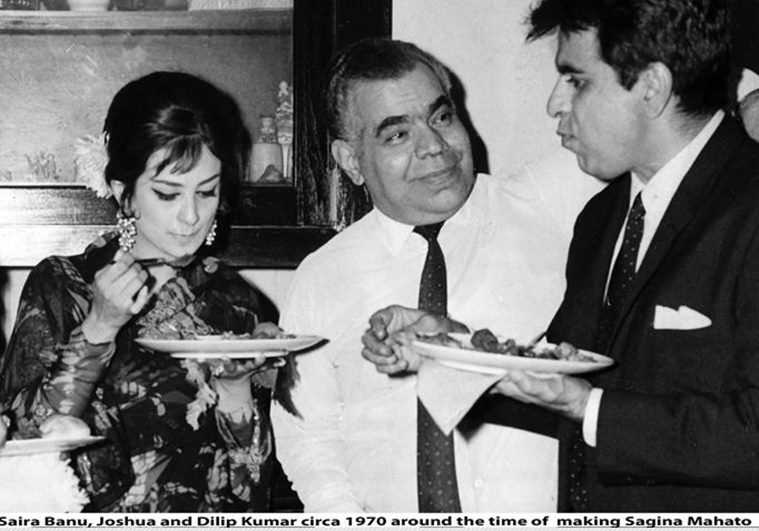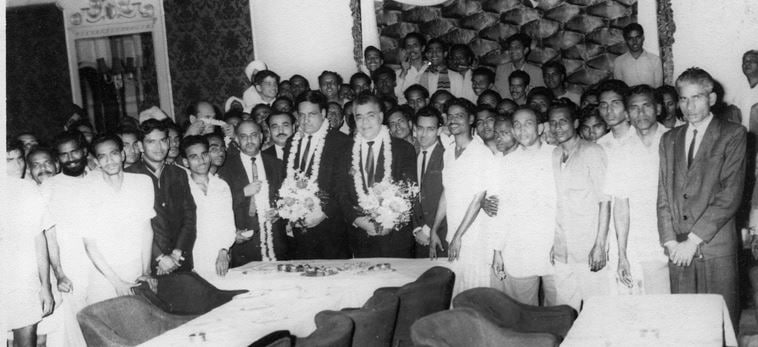

Usha Uthup performing at Trinca’s, 50 years after she first performed at the venue. (Neha Banka)
“It all started with a woman singing in a sari, something that wasn’t worn on a live-music stage at that time,” says Usha Uthup remembering her debut at Trinca’s half a century ago. A debut that changed Kolkata, the capital of India’s live music and party scene then. This was a Kolkata where establishments like Trinca’s would keep spare ties and jackets for those who would walk in without the essentials of their dress code.
But Park Street, Kolkata’s main thoroughfare, has undergone many more transformational changes over the decades. The street’s pavements are packed now with hawkers and pedestrians jostling for space, and the iconic restaurants and bars are fewer, with many establishments falling prey to gentrification over the years.
But for at least four decades, Park Street was synonymous with Kolkata’s live music industry, although now only a handful of restaurants and bars host live music performances. Despite this change, the historical association between the street and live music hasn’t quite diminished.
In the constant chaos of Park Street, 60-year-old Trinca’s is one of the last remaining establishments that is a throwback to when the neighbourhood was the epicentre of entertainment in the city. It was originally opened as a tea room and confectionary in the 1930s, when the city was still called Calcutta, by a Swiss couple for whose names public records could not be found.
 Trincas as it stands today, on Park Street. (Neha Banka)
Trincas as it stands today, on Park Street. (Neha Banka)
What is known, however, is that the establishment was named ‘Trincas’ after the couple’s last name. The tea room switched hands in 1959 when the establishment was purchased by Om Prakash Puri and Ellis Joshua, both Calcutta residents working in the city’s hospitality industry, who decided to make it a restaurant and live-music bar and renamed it ‘Trinca’s’.
Calcutta, India’s entertainment ‘capital’
“Calcutta was the entertainment capital of India in the late 1950s, right up to the 70s,” remembers Deepak Puri, 68, who inherited the management of Trinca’s from his father Om Prakash in the 1980s. “Calcutta was the financial capital of India at that time, so all the corporates were here.”
The live music industry in Kolkata developed due to a combination of factors. “Western music”, as it was called, was a legacy of British colonialism in India and during the British Raj, Park Street had slowly developed from a residential neighbourhood housing long-time city residents as well as corporate employees, with a smattering of high-end restaurants and bars that were frequented by a mostly expatriate clientele.
Nondon Bagchi, a city-based drummer for Chequered Tricycle, a 1970s rock-band, says the live music industry in Kolkata developed as a result of foreign troops, mainly US GI soldiers who were stationed in the city during the Second World War. “There was a lot of entertainment for foreign troops in Park Street, at the Great Eastern Hotel, in Dharmatala & Mission Row and central Calcutta. There were restaurants and nightclubs on Chowringhee as well.
 Actors Saira Banu and Dilip Kumar with Trinca’s co-owner Ellis Joshua in 1970 at Trinca’s, around the time the actors were filming ‘Sagina Mahato’, a Bengali film that released in 1970. (Photo courtesy: Trinca’s)
Actors Saira Banu and Dilip Kumar with Trinca’s co-owner Ellis Joshua in 1970 at Trinca’s, around the time the actors were filming ‘Sagina Mahato’, a Bengali film that released in 1970. (Photo courtesy: Trinca’s)
Firpo’s (an iconic Kolkata restaurant established in 1917 by an Italian national that closed in the 1970s) and all these places, they all had live entertainment. There was also stand-up comedy and ventriloquism,” adds Bagchi, a veteran musician whose first performance was at Trinca’s five decades ago.
Anglo-Indians — the ‘heart’ of Kolkata
The credit for nurturing and sustaining the live music industry in Kolkata rests entirely on the city’s Anglo-Indian community, believes Bagchi. “It carried on mainly because of the Anglo-Indians and to some extent the Goans. And then when there was a slump in the 70s, suddenly live entertainment was almost dead.”
Bagchi recalls a conversation he once had with Ellis Joshua, the former co-owner of Trinca’s: “He said people will say this and that; it’s because of the (entertainment) tax the government imposed. But the main reason why live entertainment took a slogging was because the Anglo-Indians went away to Australia, Canada and the UK.”
The Anglo-Indian community in the city has been synonymous with the live music industry in Kolkata. But the community’s numbers have steadily dwindled as many emigrated overseas. “When they went away, the entertainment was hit hard and even the audience completely changed. There were no more Anglo-Indians who understood western music and there was nobody to give encouragement to the performers. A performer performs well only if there is motivation from the audience. So their performance was affected,” says Bagchi.
Star composer Louiz Banks, singer Pam Craine and jazz master Carlton Kitto were among those who started out in the restaurants and bars of Park Street and then went on to become icons of the live-music industry in India. Individuals familiar with the live music industry in the city say almost all of the biggest live music singers and musicians in Kolkata have performed at Trinca’s at least once in their careers.
 On one wall of Trinca’s is an enlarged old photo of the restaurant from the 1970s and a black-and-white photo of Eve, a famous crooner who was known only by her first name. (Neha Banka)
On one wall of Trinca’s is an enlarged old photo of the restaurant from the 1970s and a black-and-white photo of Eve, a famous crooner who was known only by her first name. (Neha Banka)
“The Anglo-Indians were the heart of Calcutta. They lived for today. All the musicians came from their community,” says Puri. In those days, people wouldn’t think of going into western music because it was “taboo”, he adds, explaining how many parents in Kolkata preferred their children were trained in Indian classical music at that time.
But the community’s link wasn’t limited to entertainment and music performances in the restaurant business.
According to Puri, the stewards and employees in most restaurants and bars were Anglo-Indians because they could converse in English. “The customer base was very westernised and we still had a hangover of the British Raj… somehow the Anglo-Indians were far more affable,” he explains. “The Anglo-Indian community made Calcutta what it was and Calcutta had the best (music) talent.”
Decline of Kolkata’s live music industry
During the Naxalite movement in the late 1960s and 1970s in Bengal, the political turmoil impacted most businesses and commercial enterprises in the city. Many in the Anglo-Indian community began moving abroad for better economic prospects. Business slowed down and establishments couldn’t hold on for long. Firpo’s closed down, as did several other icons of the city’s food culture.
“The political scenario changed here and in 1969-1970 the trouble started and corporates started moving out. So we went through rough years in Calcutta, especially in the restaurant industry,” remembers Puri. The Left Front government in West Bengal levied high taxes on entertainment forcing establishments to stop hosting live music, which in turn impacted customer footfall.
“You had to pay 30 per cent entertainment tax to listen to music. It was quite ridiculous,” says Puri. “Here if a person was having a scotch, he was paying Rs. 20 for a drink, and person having a Coke was paying Re 1. So the person having a Coke was paying 30 paise entertainment tax, and the person who was paying Rs. 20 was paying Rs. 6 as entertainment tax.”
Puri recalls being a part of the group that protested this government-enforced entertainment tax and took the matter to court. “We fought it because it was an unfair tax…and entertainment tax was abolished.”
However, by then it was too late. Several restaurants in the Park Street and Chowringhee area had closed down.
Around the same time, Park Street residents who were employees of corporations, began leaving the city after the corporations relocated their operations elsewhere in India and the residential apartments in the sprawling old colonial buildings began transforming to hastily modified cramped office spaces. The revival had to wait till the 1980s.
 Om Prakash Puri and Ellis Joshua, co-owners of Trinca’s, with staff after renovations of the restaurant in 1961. (Photo courtesy: Trinca’s)
Om Prakash Puri and Ellis Joshua, co-owners of Trinca’s, with staff after renovations of the restaurant in 1961. (Photo courtesy: Trinca’s)
Today, Park Street is congested with electronics shops, modern cafes and restaurants with jarring signage and billboards plastering the concrete overhangs of the colonial buildings that they have occupied. Among the handful of restaurants that have survived the onslaught of gentrification are Trinca’s, Flurys, Mocambo, Magnolia and Moulin Rouge—all restaurants from another era in the city.
Keeping the flavour
Both Om Prakash Puri and Ellis Joshua were friends who had worked together at the Oberoi Grand Hotel, an upscale hotel on Chowringhee, a stone’s throw from Park Street during the 1950s. Their experience in the hospitality industry in one of Kolkata’s leading hotels and at other hotels across India gave them the experience they needed to convert Trinca’s into a live music restaurant from the tea room that it was.
“For the first two years we ran it as a confectionary and tea room. We had a huge bakery selling everything from cakes, pastries, breads, tea, coffee—what Flurys is today,” says Puri. The partners changed the look of the tea room that was Trincas but kept the name, and added an apostrophe to its new nomenclature; Trinca’s. “It was a very popular tea room, but the times were changing,” confesses Puri. In 1961, Trincas fully transformed from a tea room after the partners acquired liquor licenses and emerged as an entertainment hot-spot in the city. After Joshua passed away, Puri acquired sole management of Trinca’s.
 An undated promotional flyer for Christmas cakes when the establishment was still called Trincas and operated as a confectionary and tea room. (Photo courtesy: Trinca’s)
An undated promotional flyer for Christmas cakes when the establishment was still called Trincas and operated as a confectionary and tea room. (Photo courtesy: Trinca’s)
As is common in the architectural style in old colonial structures in Kolkata, the original door to Trinca’s was approximately 18 feet high and a secondary door made of steel mesh kept the flies away from the confections.
Today, the door is smaller, a sliver in a corner that opens into the dimly lit restaurant, washed in colours of muted reds and ochre. The restaurant seats approximately 150 people with a small platform in the back for bands to play live music. A long, partially-frosted glass window has replaced the 18-foot-high original doorway and tables placed nearby offer customers an unparalleled view of the Park Street and Russell Street crossing and the grand facade of Queens Mansion, one of the last remaining colonial buildings in that stretch of the city.
The dress code at Trinca’s is no longer formal and the restaurant doesn’t keep a stock of emergency neckties and jackets for customers who arrive without one. “You can’t really expect people to come to you wearing a suit, a jacket and tie. It was compulsory earlier for any gentleman entering the restaurant in the evening to have a tie and jacket, right up till 1973,” said Puri. The restaurant would keep extra neckties and jackets in standard sizes on hand because of dress codes in force across most restaurants in the city at that time. “It wouldn’t match (with their clothes) but the idea was to get them into it. Believe it or not, putting a jacket and tie would make them behave themselves,” laughs Puri. “It made them conscious that they had to behave.”
Good times at Trinca’s
Coinciding with Trinca’s 60th anniversary is the 50th anniversary of Kolkata-based singer Usha Uthup’s first stage performance. Last weekend, Uthup took the stage at Trinca’s once more, the very place from where she started her music career. Many who were present at Trinca’s the first night she performed five decades ago gathered to hear her sing at the venue once again.
“When I think about the good times, I think about Trinca’s. Otherwise I wouldn’t have come down for it,” says Bharat Mani Pradhan, 71, a printer-publisher based in Kalimpong, who visited Kolkata for two days just to catch Uthup’s anniversary performance. “You know the song ‘Jamaica Farewell’? The first time I heard it was (when she sang). She used to (also sing) calypso. She used to sing ‘Besame Mucho’ when she became pensive and serious.”
 The interiors of Trinca’s. today. (Neha Banka)
The interiors of Trinca’s. today. (Neha Banka)
Speaking to indianexpress.com, in the midst of a late lunch at Trinca’s a day before Uthup’s performance, Pradhan suddenly becomes quiet, remembering the night all those years ago when he first heard Uthup sing. Interrupting his meal of baked Bhekti fish in rice and béchamel, Pradhan breaks into song, humming a few lines from ‘Jamaica Farewell’ : /“Down the way where the nights are gay/ And the sun shines daily on the mountain top/I took a trip on a sailing ship/And when I reached Jamaica I made a stop.”/
Kaveri Dutt, 74, and her husband Ashok had come back to Trinca’s with their friends, Rina and S K Banerjee to hear Uthup sing. “We’ve known Usha & Jani (Usha’s husband) for a long time. This area, Park Street, Trinca’s, Pam Craine, Usha—it used to be a wonderful era. Well, maybe we have nostalgia of our times and I have retained my memories of this place,” says Dutt.
The four friends have known Uthup from the time she moved to Kolkata as a young woman to pursue her dreams of music and were also present at Trinca’s when Uthup first performed there. “During our days it used to be totally different with the live band along with the crooners. On the dance floor, we used to dance to foxtrot and quickstep, rumba, samba, the cha-cha-cha. It was a different world in those days. At my age perhaps there has been a transition and we must step in with the times,” says Dutt.
A place for firsts
For Usha Uthup, Trinca’s is “hallowed ground”. “It’s where I got all the good things in my life. I met my husband there,” she tells indianexpress.com. Trinca’s was also a place for several firsts for Uthup. Not only was the restaurant the place where she started her professional music career, it was also where she got her first taste of paneer. “Being a south Indian, I never knew what paneer was. I had my first taste of paneer at Trinca’s,” laughs Uthup. What sets Trinca’s apart even today, she says, is that it never stopped playing live-music within its walls, its ambience and its association with the Anglo-Indian community in the city.
 Usha Uthup performing at Trinca’s. Year unknown. (Photo courtesy: Trinca’s)
Usha Uthup performing at Trinca’s. Year unknown. (Photo courtesy: Trinca’s)
When she first started performing, Uthup says, calypso music was “big” and she had plans to sing some of the numbers she knows her audience will expect of her on the anniversary night. ‘Matilda’ and ‘Jamaica Farewell’ have always been popular requests that Uthup makes sure to sing each time she performs, especially in Kolkata.
On the evening of her anniversary performance at Trinca’s, Uthup, dressed in a black and gold kanjeevaram sari with a white/gajra/in her hair, walked up to the same stage once again, 50 years after her first performance many nights ago, with many familiar faces in an eager audience.





